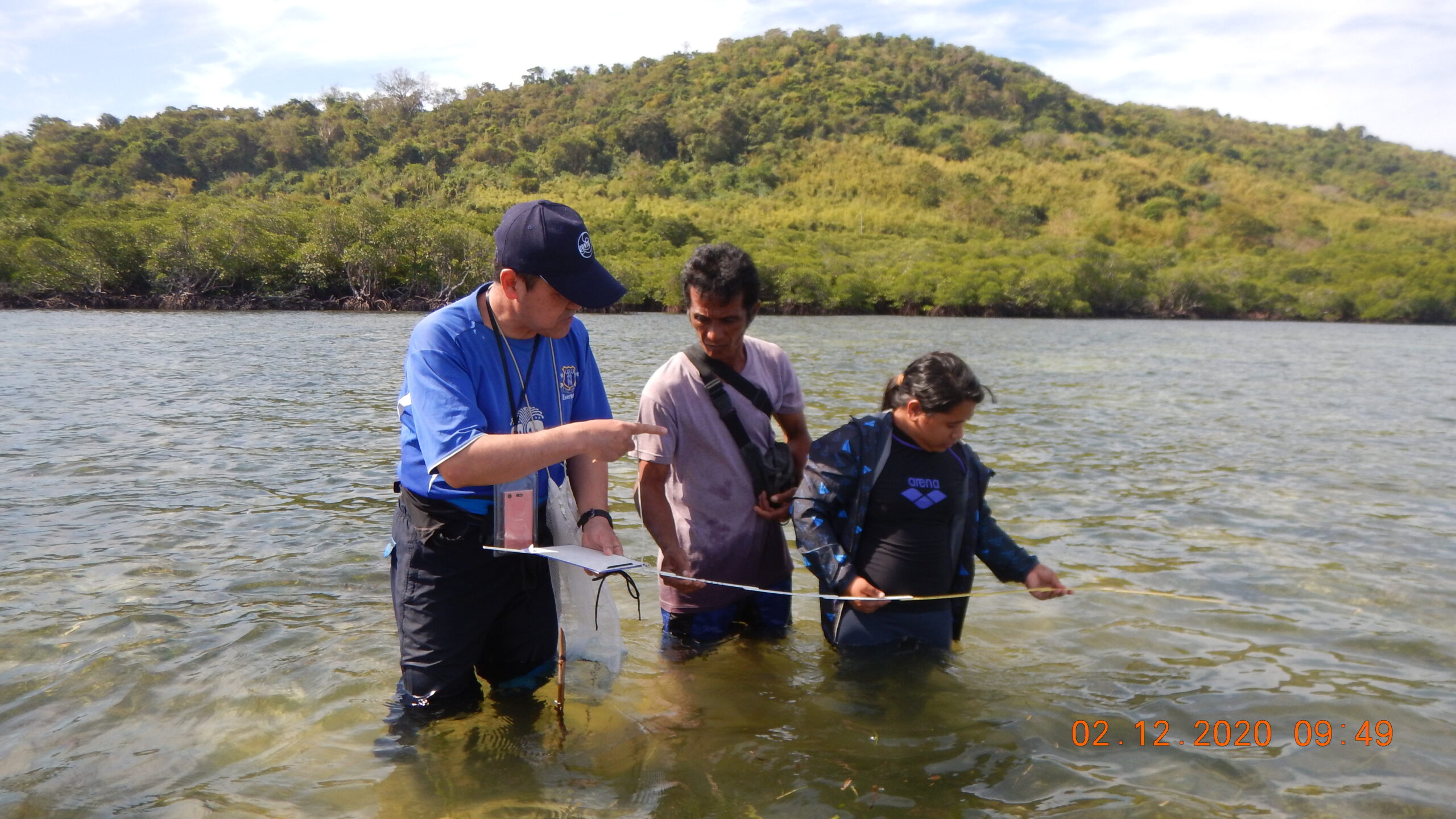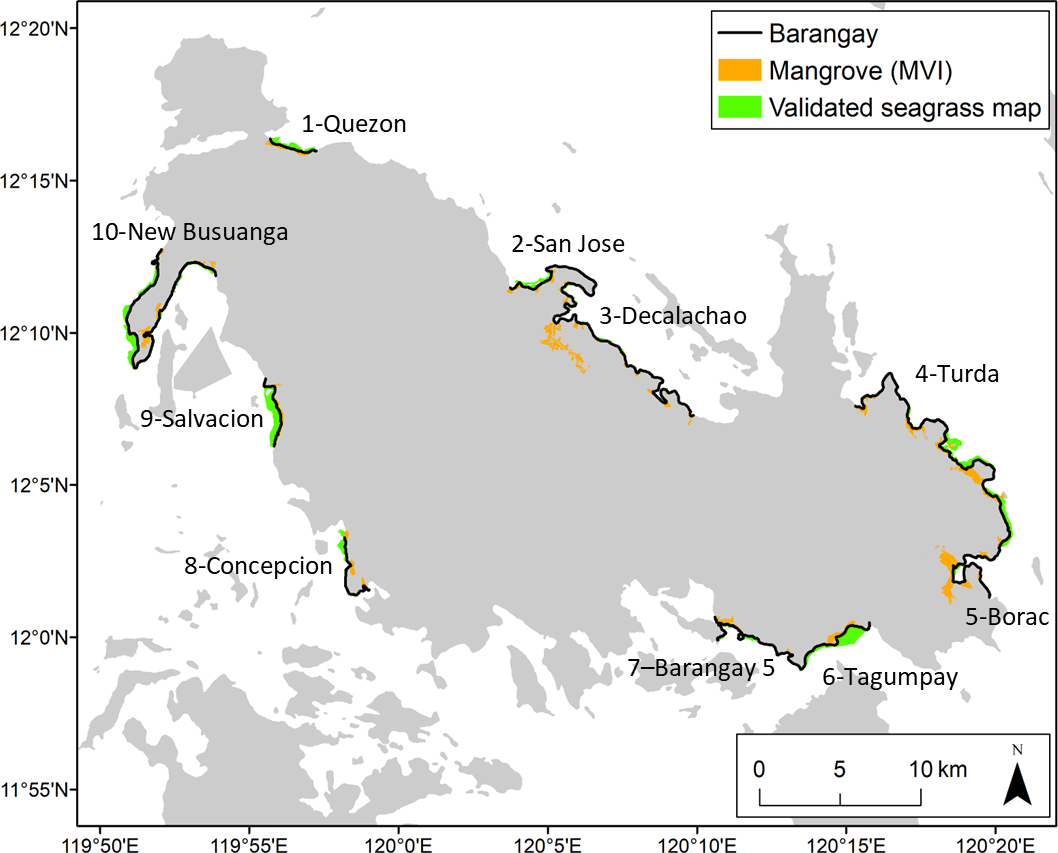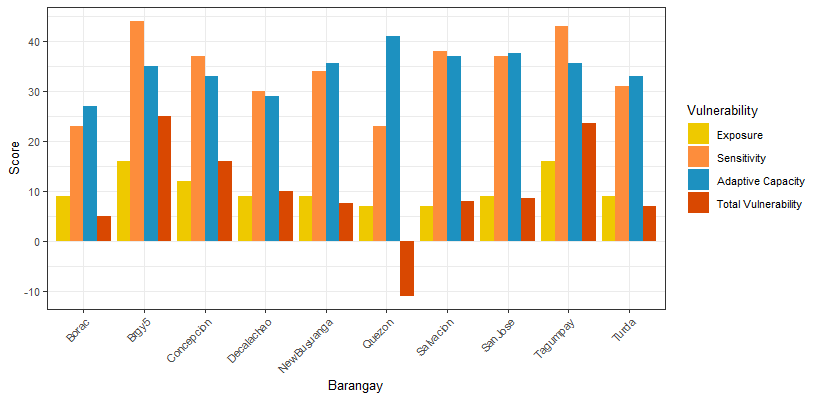Social vulnerabilities of coastal communities and their reliance on blue carbon ecosystem services may be improved by addressing three major factors, according to a study led by Hokkaido University researchers.

From the left: Masahiro Nakaoka, Hokkaido University; Rommel Llanillo, BFARMC Chairperson, Barangay Quezon; and Muammar Princess Soniega, Programme Officer, C3 Philippines, assessing seagrass abundance and species diversity in Barangay Quezon, Busuanga, during the study (Photo: T. E. Angela L. Quiros).
Ecosystem services (ES) are benefits nature provides to humans. In coastal areas, seagrass meadows and mangroves provide key ecosystem services, including carbon sequestration and climate mitigation. The carbon sequestered in coastal and marine vegetated ecosystems is known as blue carbon, and the ecosystems are usually referred to as blue carbon ecosystems. Blue carbon ecosystems are being lost at a high rate in Southeast Asia. This is problematic because local communities living on the coast heavily rely on seagrasses and mangroves for provisioning services such as livelihoods and food security.
A team of scientists from Japan and the Philippines, including Dr. T. E. Angela Quiros, Dr. Kenji Sudo and Professor Masahiro Nakaoka of the Field Science Center for Northern Biosphere at Hokkaido University's Akkeshi Marine Station, examined the social vulnerability of fishing communities that rely on blue carbon ecosystems. The Hokkaido University team collaborated with Busuanga-based NGO C3 Philippines and members of the local government, as well as the Busuanga community for the field collections. Their findings, presented at the sixth International Marine Conservation Congress (IMCC6) and published in the journal Frontiers in Marine Science, suggest conservation strategies to manage social vulnerabilities of coastal communities who rely on blue carbon ecosystems.
The scientists examined how ten fishing communities on Busuanga Island, Palawan Province, Philippines responded to the loss or degradation of blue carbon ecosystems, namely seagrasses and mangroves. They assessed the ES provision for small-scale fisheries in multiple ways. They performed ecological assessments of seagrass beds, spatial analysis of seagrass and mangroves along the coast, fisher landing surveys, household and key informant interviews. This wealth of data was used to map social vulnerability in 3 criteria: Exposure, or threats to the blue carbon ecosystems; Sensitivity, or the local importance of blue carbon ecosystems; and Adaptive Capacity, the assets available to avoid impacts in the future from the loss of blue carbon ecosystems.

The 10 fishing communities on Busuanga Island surveyed in this study. Black lines indicate the barangay (administrative district) in which each community is located; and mangroves and seagrass beds used by each community are indicated by orange and green, respectively (T. E. Angela L. Quiros, et al. Frontiers in Marine Sciences. August 3, 2021).
Seagrass ecosystems and their fisheries were more vulnerable to loss and degradation than mangrove ecosystems and fisheries as it takes more effort to catch the same amount of fish from seagrass ecosystems compared to mangrove ecosystems. Furthermore, certain seagrass meadows and mangrove forest types were more sensitive as they occupied a smaller area of the coastline and were host to lower species numbers; others had decreased adaptive capacity due to physical isolation and hosting species with slower growth.
Socio-economic sensitivity increased in communities with greater reliance on fisheries and tourism income. Communities with low adaptive capacity were mainly composed of fisherfolk with low education levels and high average fishing experience, and thus few alternatives to fishing. Urbanized (Barangay 5, Tagumpay) communities were more vulnerable than rural communities (Borac, Quezon, Turda) due to degraded blue carbon ecosystems, greater population density and threats from tourism and development.

The social vulnerability of each community surveyed in this study, broken down into the three criteria and combined to determine the total vulnerability (T. E. Angela L. Quiros, et al. Frontiers in Marine Sciences. August 3, 2021).
Across all communities, adaptive capacity was constrained by the lack of education, but increased with diversified livelihoods and access to information from and initiatives by NGOs and community organizations.
"Our findings show the need to improve access to education, increase NGO activities and the number of organizations around blue carbon ecosystems, and initiate equitable fisheries management for the vulnerable seagrass and mangrove fisheries," says Angela Quiros.
Original Article:
T. E. Angela L. Quiros, et al. Blue Carbon Ecosystem Services Through a Vulnerability Lens: Opportunities to Reduce Social Vulnerability in Fishing Communities. Frontiers in Marine Sciences. August 3, 2021.
DOI: 10.3389/fmars.2021.671753
Funding:
This study was funded by Japan International Cooperation Agency (JICA) and Japan Science and Technology Agency (JST) under the Science and Technology Research Partnership for Sustainable Development (SATREPS) Program.






